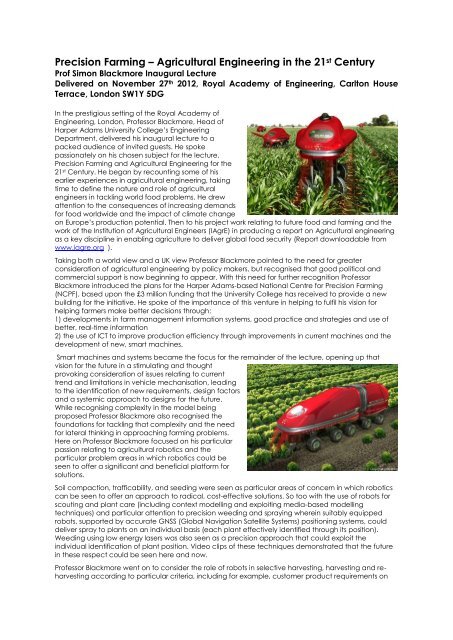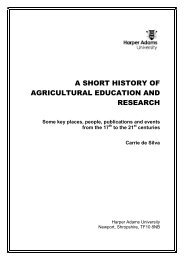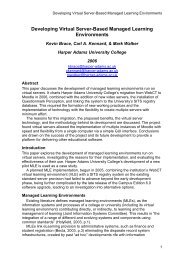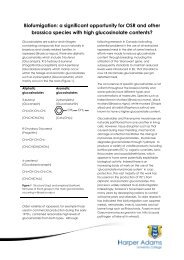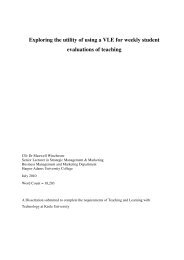Precision Farming - Agricultural Engineering in the 21st Century
Precision Farming - Agricultural Engineering in the 21st Century
Precision Farming - Agricultural Engineering in the 21st Century
Create successful ePaper yourself
Turn your PDF publications into a flip-book with our unique Google optimized e-Paper software.
<strong>Precision</strong> <strong>Farm<strong>in</strong>g</strong> – <strong>Agricultural</strong> <strong>Eng<strong>in</strong>eer<strong>in</strong>g</strong> <strong>in</strong> <strong>the</strong> 21 st <strong>Century</strong>Prof Simon Blackmore Inaugural LectureDelivered on November 27 th 2012, Royal Academy of <strong>Eng<strong>in</strong>eer<strong>in</strong>g</strong>, Carlton HouseTerrace, London SW1Y 5DGIn <strong>the</strong> prestigious sett<strong>in</strong>g of <strong>the</strong> Royal Academy of<strong>Eng<strong>in</strong>eer<strong>in</strong>g</strong>, London, Professor Blackmore, Head ofHarper Adams University College’s <strong>Eng<strong>in</strong>eer<strong>in</strong>g</strong>Department, delivered his <strong>in</strong>augural lecture to apacked audience of <strong>in</strong>vited guests. He spokepassionately on his chosen subject for <strong>the</strong> lecture,<strong>Precision</strong> <strong>Farm<strong>in</strong>g</strong> and <strong>Agricultural</strong> <strong>Eng<strong>in</strong>eer<strong>in</strong>g</strong> for <strong>the</strong>21 st <strong>Century</strong>. He began by recount<strong>in</strong>g some of hisearlier experiences <strong>in</strong> agricultural eng<strong>in</strong>eer<strong>in</strong>g, tak<strong>in</strong>gtime to def<strong>in</strong>e <strong>the</strong> nature and role of agriculturaleng<strong>in</strong>eers <strong>in</strong> tackl<strong>in</strong>g world food problems. He drewattention to <strong>the</strong> consequences of <strong>in</strong>creas<strong>in</strong>g demandsfor food worldwide and <strong>the</strong> impact of climate changeon Europe’s production potential. Then to his project work relat<strong>in</strong>g to future food and farm<strong>in</strong>g and <strong>the</strong>work of <strong>the</strong> Institution of <strong>Agricultural</strong> Eng<strong>in</strong>eers (IAgrE) <strong>in</strong> produc<strong>in</strong>g a report on <strong>Agricultural</strong> eng<strong>in</strong>eer<strong>in</strong>gas a key discipl<strong>in</strong>e <strong>in</strong> enabl<strong>in</strong>g agriculture to deliver global food security (Report downloadable fromwww.iagre.org ).Tak<strong>in</strong>g both a world view and a UK view Professor Blackmore po<strong>in</strong>ted to <strong>the</strong> need for greaterconsideration of agricultural eng<strong>in</strong>eer<strong>in</strong>g by policy makers, but recognised that good political andcommercial support is now beg<strong>in</strong>n<strong>in</strong>g to appear. With this need for fur<strong>the</strong>r recognition ProfessorBlackmore <strong>in</strong>troduced <strong>the</strong> plans for <strong>the</strong> Harper Adams-based National Centre for <strong>Precision</strong> <strong>Farm<strong>in</strong>g</strong>(NCPF), based upon <strong>the</strong> £3 million fund<strong>in</strong>g that <strong>the</strong> University College has received to provide a newbuild<strong>in</strong>g for <strong>the</strong> <strong>in</strong>itiative. He spoke of <strong>the</strong> importance of this venture <strong>in</strong> help<strong>in</strong>g to fulfil his vision forhelp<strong>in</strong>g farmers make better decisions through:1) developments <strong>in</strong> farm management <strong>in</strong>formation systems, good practice and strategies and use ofbetter, real-time <strong>in</strong>formation2) <strong>the</strong> use of ICT to improve production efficiency through improvements <strong>in</strong> current mach<strong>in</strong>es and <strong>the</strong>development of new, smart mach<strong>in</strong>es.Smart mach<strong>in</strong>es and systems became <strong>the</strong> focus for <strong>the</strong> rema<strong>in</strong>der of <strong>the</strong> lecture, open<strong>in</strong>g up thatvision for <strong>the</strong> future <strong>in</strong> a stimulat<strong>in</strong>g and thoughtprovok<strong>in</strong>g consideration of issues relat<strong>in</strong>g to currenttrend and limitations <strong>in</strong> vehicle mechanisation, lead<strong>in</strong>gto <strong>the</strong> identification of new requirements, design factorsand a systemic approach to designs for <strong>the</strong> future.While recognis<strong>in</strong>g complexity <strong>in</strong> <strong>the</strong> model be<strong>in</strong>gproposed Professor Blackmore also recognised <strong>the</strong>foundations for tackl<strong>in</strong>g that complexity and <strong>the</strong> needfor lateral th<strong>in</strong>k<strong>in</strong>g <strong>in</strong> approach<strong>in</strong>g farm<strong>in</strong>g problems.Here on Professor Blackmore focused on his particularpassion relat<strong>in</strong>g to agricultural robotics and <strong>the</strong>particular problem areas <strong>in</strong> which robotics could beseen to offer a significant and beneficial platform forsolutions.Soil compaction, trafficability, and seed<strong>in</strong>g were seen as particular areas of concern <strong>in</strong> which roboticscan be seen to offer an approach to radical, cost-effective solutions. So too with <strong>the</strong> use of robots forscout<strong>in</strong>g and plant care (<strong>in</strong>clud<strong>in</strong>g context modell<strong>in</strong>g and exploit<strong>in</strong>g media-based modell<strong>in</strong>gtechniques) and particular attention to precision weed<strong>in</strong>g and spray<strong>in</strong>g where<strong>in</strong> suitably equippedrobots, supported by accurate GNSS (Global Navigation Satellite Systems) position<strong>in</strong>g systems, coulddeliver spray to plants on an <strong>in</strong>dividual basis (each plant effectively identified through its position).Weed<strong>in</strong>g us<strong>in</strong>g low energy lasers was also seen as a precision approach that could exploit <strong>the</strong><strong>in</strong>dividual identification of plant position. Video clips of <strong>the</strong>se techniques demonstrated that <strong>the</strong> future<strong>in</strong> <strong>the</strong>se respect could be seen here and now.Professor Blackmore went on to consider <strong>the</strong> role of robots <strong>in</strong> selective harvest<strong>in</strong>g, harvest<strong>in</strong>g and reharvest<strong>in</strong>gaccord<strong>in</strong>g to particular criteria, <strong>in</strong>clud<strong>in</strong>g for example, customer product requirements on


